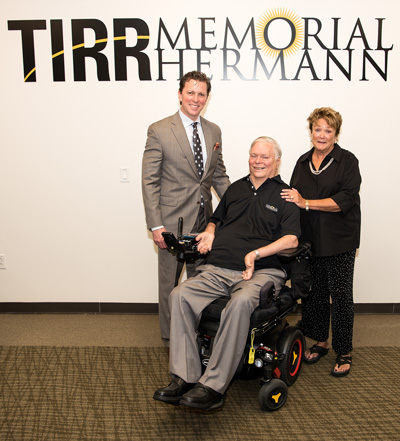The purpose of rehabilitation is to protect the individuality of the person facing disability and to provide opportunities to pursue goals, expectations and dreams that are important to that individual. That's what makes you a person. Having some control over your existence is a basic human right. My vision was guided by how much people could do in spite of tremendous losses.
Jack Emmott was diagnosed with polio in 1954, less than a year before the first polio vaccine was available in the United States. In one afternoon, at the age of six, he went from mobility to paralysis.
“I crawled on my knees to the staircase and called to my mother. She came upstairs, and by then I couldn’t even get up on my knees,” he says. “When the doctor arrived at our house, I couldn’t move my arms and legs and had no reflexes. Dad carried me out to our 1954 Oldsmobile Delta 88 and put my head on a pillow on Mom’s lap.”
Emmott has been a patient at TIRR Memorial Hermann since its early days as the Southwestern Poliomyelitis Respiratory Center, one of the first polio treatment centers in the United States. In 1951, Dr. William Spencer, a young pediatrician recently discharged from the U.S. Army, was recruited by Baylor College of Medicine and the National Foundation for Infantile Paralysis to lead the center’s staff of clinicians. As the polio epidemic swept the nation, patients from across the Southwest were sent to the center, which at one time managed more than 10% of the 38,000 new cases of polio that occurred annually.
“When the polio epidemic hit, my father became frantic,” recalls Susan Spencer Tully. “As a pediatrician and old school-trained doctor, he was committed to curing kids. But he couldn’t cure this disease, and when he saw the crippling it caused and the stigma associated with it, the kids confined to iron lungs and young people being sent to nursing homes for the rest of their lives, he wanted to do something innovative. He always said, ‘Even though the body is broken, the mind still works.’ He wanted to make sure that people with disabilities had the opportunity to use their skills and talents to the greatest degree possible. He was also very committed to research into ways to live with paralysis.”
The center quickly became known for groundbreaking work. Dr. Spencer was involved in developing the physiograph, a device hailed in the March 22, 1954, issue of Life magazine for its ability to record vital functions. The technology advanced teaching and research efforts and is recognized as a prototype for the sophisticated monitoring systems used today. During that first decade, he also recruited visionary academic physicians from different disciplines, who treated patients in a small building tucked away in a corner of the rapidly expanding Texas Medical Center. Among them were pediatric pulmonologist Gunyon Harrison, MD; Carlos Vallbona, MD, a pediatrician from Barcelona, Spain; R. Edward Carter, MD, an internist; and Paul Harrington, MD, an orthopedic surgeon with an interest in scoliosis. Jack Emmott, who is now 71, was cared for by all four physicians.
By the late 1950s, when the polio vaccine made the disease less of a universal threat, Dr. Spencer and his team refocused the core clinical knowledge developed from the rehabilitation of patients with polio to the care of people with catastrophic injuries and illnesses. His efforts in treating polio survivors led to the donation of funds by the March of Dimes and other organizations for a not-for-profit hospital that opened in 1959 as the Texas Institute for Rehabilitation and Research, later renamed The Institute for Rehabilitation and Research (TIRR).
Widely regarded as one of the Fathers of Modern Rehabilitation, Dr. Spencer guided TIRR to become a worldwide model for comprehensive medical rehabilitation programs, serving as president until his retirement in 1987. Under his leadership, the hospital gained national recognition for its innovative and pioneering programs, including one of the country’s first intensive care units. He was a strong advocate for people with disabilities, serving as the first acting director of the National Association of the Handicapped, which was created along with the National Institute on Disability and Rehabilitation Research, now called the National Institute on Disability, Independent Living and Rehabilitation Research (NIDILRR).
In 1961, Jack Emmott, then 13, was among those who benefited from Dr. Paul Harrington’s innovative approach to scoliosis using what became known as Harrington rods. “When curvature of the spine threatened to end my life, my mother took me to see Dr. Harrington, who was a visionary orthopedic surgeon,” Emmott says. “In a five-hour surgery, he made an incision down the midline of my back from the base of the neck to just above my tailbone. He placed three steel rods in the bow of my spine to keep it from bending further. After the surgery, I was three inches taller. That surgery allowed me to grow far more as a person than the three inches of height I gained.” He underwent three more surgeries performed by Dr. Harrington, the last of which was replacement of a broken rod.
In 1988, at the age of 40, Emmott began suffering significant late effects of polio, known as post-polio syndrome. Common symptoms include slowly progressive muscle weakness, generalized and muscular fatigue and muscle atrophy. Pain from joint degeneration and increasing skeletal deformities also is common. Dr. Vallbona, who had been Emmott’s physician since 1962, treated him for respiratory muscle weakness.
“I had respiratory fatigue and was literally dying,” he says. “Dr. Vallbona managed my care for the next four years, during which I slept in an iron lung every night. Eventually I was weaned off the iron lung and was able to function with an oral-nasal mask connected to a ventilator.”
Today Emmott is senior counsel at Gray Reed & McGraw LLP, a mid-sized full-service law firm in Houston, Dallas and Waco, Texas. A board-certified Family Law Specialist, he has practiced family law for more than 40 years and is the author of two books; the most recent is Bending Angels: Living Messengers of God’s Love. He visits TIRR Memorial Hermann Outpatient Medical Clinic and the hospital’s Post-polio Clinic when he needs help with pain management and other manifestations of the syndrome.
“Polio survivors who are fortunate enough to go to TIRR have caregivers who understand us and give us access to the resources we need,” Emmott says. “A lot of institutions serve people with disabilities but don’t give them a place to be, but TIRR did this from the very beginning. The leadership at TIRR was among the first nationally to employ people with disabilities, and these people were inspirational to us as patients. When you have a disability, the real challenge is to let light shine out of the darkness and know that you can be something and make a difference. I’m the best me I can be, and I wouldn’t be here if it weren’t for Dr. Spencer, Dr. Harrington, Dr. Vallbona and others at TIRR.”
Dr. Spencer was succeeded by R. Edward Carter, MD, a leader in SCI care, and then by internationally recognized academic physiatrist William H. Donovan, MD, who served as executive vice president for medical affairs at TIRR Memorial Hermann. He is widely known for his expertise in treating people with spinal cord injury and amputations. After joining the medical staff in 1980, he later succeeded Dr. Carter as director and principal investigator of the Texas Model System Spinal Cord Injury System grant, awarded by NIDILRR. In addition to his accomplishments at TIRR, he led the development of the department of Physical Medicine and Rehabilitation at McGovern Medical School at UTHealth, which began as a division of the department of Neurosurgery in 1993 and was established as an independent entity under his chairmanship the following year.
Shortly thereafter, NIDILRR also named TIRR’s Brain Injury Program a Model System, and U.S. News & World Report announced its first America’s Best Hospitals list, which included TIRR. The innovative Challenge Program, begun as part of the Brain Injury Program, opened its facility in southwest Houston, in keeping with the hospital’s philosophy of community-based service programming. The Southwest Disability and Business Technical Assistance Center (DBTAC), one of 10 federally designated regional technical assistance centers on the Americans with Disabilities Act, was established at TIRR’s Independent Living Research Utilization’s (ILRU), and TIRR joined the Memorial Hermann Health System as TIRR Memorial Hermann.
Dr. Donovan retired in 2008 after 28 years of service. He remembers the remarkable passion of the entire hospital staff. “That passion is a reflection of their love for their work and also of their belief that they are accomplishing something very important,” he says. “Patients come in after catastrophic illness or injury, and they leave much better prepared for their return to the community. The more we recognize that people can contribute to society despite their disabilities, the more we understand that they belong in the world, not at home, which leads us to embrace initiatives to break down barriers.”

Today, as TIRR Memorial Hermann celebrates its 60th anniversary, the hospital is ranked the best in the southern half of the United States, according to U.S. News & World Report’s annual listing of Best Hospitals for Rehabilitation. The hospital has ranked among the top five in the country in all but three years since the magazine began publishing the list 30 years ago.
Following in Dr. Spencer’s footsteps, TIRR Memorial Hermann has historically balanced its clinical treatment programs with initiatives in applied research. Early on, the hospital collaborated with NASA to carry out research on the effects of weightlessness, and in studies to determine the potential usefulness of centrifuge therapy for astronauts on deep-space missions. Longstanding affiliations with Baylor College of Medicine and McGovern Medical School have led to local collaborations with researchers from the University of Houston, Rice University, Texas Woman’s University and several other academic institutions, as well as international collaborations with universities in Mexico, Spain and China. Investigators at the TIRR Memorial Hermann Research Center currently hold funding of $34.5 million, including the prestigious Model Systems designation in spinal cord jury and traumatic brain injury.
“Our research projects integrate the input of physicians, nurses and therapists, many of whom are engaged in their own research projects,” says Mark Sherer, PhD, ABPP, FACRM, senior scientist and associate vice president for research at TIRR Memorial Hermann and a clinical professor of physical medicine and rehabilitation at McGovern Medical School and Baylor College of Medicine. “Like most endeavors, to reach the highest level of success you need context and a solid foundation. From the beginning our leaders have been committed to providing that infrastructure. Dr. Spencer was the right person at the right time in terms of integrating TIRR into the Texas Medical Center, which gave us access to enormous research resources and investigators at other institutions. That access has kept us at a critical mass to continue moving forward with research, in line with Dr. Spencer’s original vision.”
